From What Is to What If Micro-Grants Awarded!
The mission of The BTS Center is “to catalyze spiritual imagination with enduring wisdom for transformative faith leadership.”
To that end, we offered a multi-session online program last spring, “From What Is to What If: Practicing Imagination.” Participants (who were encouraged to create “teams” from their organization or congregation) constituted a co-learning community of practice to engage imagination, drawing on the work of writer, environmental activist, and founder of the Transition movement, Rob Hopkins, who inspires moral and ecological imagination. Through shared readings and materials, conversation in group sessions, and a series of practices designed to inspire thinking and stretch imagination, participants were led to ask different questions relevant to their own contexts. And, during the course of the program, participants had the opportunity to apply for a generous micro-grant from The BTS Center that would support the manifestation of their idea for unlocking imagination in their congregations or communities.
We were delighted to receive several deeply thoughtful and experimental proposals, and were ultimately able to fund six projects, each of them not only to be an imaginative endeavor, but also designed to inspire others’ imaginations as well.
In addition to sketching a new vision for some aspect of a congregation’s work, each application referenced the intention of the program, posing the “what if …” question behind the project. We were intrigued and encouraged by the responses, and celebrate and affirm each proposal, giving thanks for the spirit of innovation and creativity present all around us.
With great joy, we are announcing the six recipients of From What Is to What If Micro-Grants. Each of these grants (up to $5,000) will help a community of faith try something new, lay the groundwork for further innovation, and help to fire the imaginations of others. We are excited about the array of projects described below, and we are grateful to partner with these faith communities by providing just a little bit of funding to help support and encourage their steps forward.
After careful review and much deliberation, we have awarded grants to each of the following faith communities:
Bismarck United Church of Christ, Bismarck, North Dakota

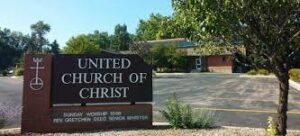
Experimenting with outdoor worship during COVID, the members and leaders of Bismarck UCC discovered something: late morning worship on the parking lot was hot, but the small lawn and part of the parking lot was shaded and perfect for outdoor services! They also discovered that neighbors would sit in their garages or open windows during worship to join in and that neighborhood kids would stop to play in the parking lot. This started them wondering: “what if our parking lot is sacred ground?” and “what if the most public part of our property, our parking lot, could wordlessly welcome people of all ages onto sacred ground and inspire play, worship, and relationship building?” Their vision, “Parking Lot to Sacred Ground,” endeavored to remove a hedge, replacing it with plantings of native and drought resistant plants to welcome people through inviting entry points, create a boundary to encourage people to intentionally and mindfully enter onto sacred ground, and provide food and habitat for local wildlife. To celebrate their project, Bismarck UCC and another local church joined forces to host a Highland Acres Block Party – welcoming new neighbors, sharing a meal, honoring important losses of the community, and honoring a local food pantry’s work. The church found it needed to be flexible in implementing the full scope of the project, delaying planting new materials due to drought and lack of knowledge of local landscapers. This, combined with the poor air quality due to wildfires in the summer of 2021, raised the consciousness of the congregation to the direct impacts of climate change on their own corner of the world.
First Parish Congregational Church, Gorham, Maine
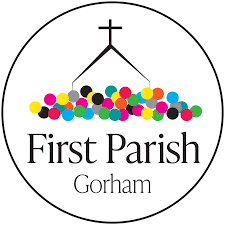
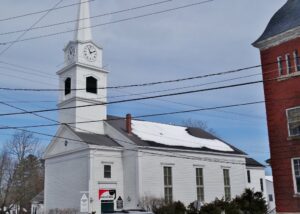
First Parish Church is highly visible in the downtown area of Gorham, Maine. Historically, Gorham Village has not been perceived as a true community center because of the traffic created by the two main roads. First Parish sought to use both its interior and exterior spaces in new and exciting ways and be a part of the connecting efforts to create a true “downtown” space in Gorham. As the Gorham team says, “Art is imagination made visible,” and so the congregation posed these questions: “What if all the publicly accessible spaces – interior and exterior – in Gorham Village became art spaces? What if the exterior street side wall of the church became an outdoor art gallery?” The team gathered town stakeholders (arts organizations, town representatives, artists, businesses) to imagine the many ways art could be present in Gorham by asking "What if...every space was an art space – what spaces do you see?" The “Inside Out” Art Show took place on the evening of May 13, 2022 with a projection of art submitted by members of the community onto the façade of the church along with a block party. The event included “What if…?” prompts for attendees to share their ideas in writing.
St. John’s Episcopal Church, Bangor, Maine

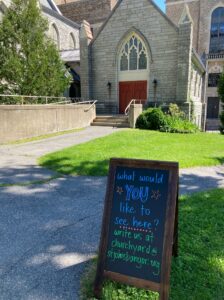
Established in 1834, St. John’s Episcopal Church is known especially for its beautifully formal Anglican liturgy and strong choral tradition. The Gothic Revival church building has a powerful presence in its neighborhood adjacent to downtown Bangor. Though the church experienced significant changes and challenges recently, including the necessity of shortening of its soaring tower, St. John’s began to use more online tools during the pandemic, which led to discerning new ways to think about community. The “What If” question the church was inspired to ask is: “What if the churchyard (and the pathway through it) were seen as a ‘thin place’ between parish and neighborhood that helped re-imagine God’s mission for St. John’s?” To that end, the grant to St. John’s supported three “pop-up” events intended to offer people a “memory of the future.” The events invited parishioners and neighbors to experience and imagine a pop-up garden to celebrate creation and community, a pop-up labyrinth and space for prayer and meditation, and a neighborhood Imagination Celebration, which also celebrated the completion and dedication of the tower project. The Church also held some summer services outdoors, hosted Christmas caroling and a nativity StoryWalk in the churchyard, and added live music to their pop-up events.
United Church of Christ, Boxborough, Massachusetts
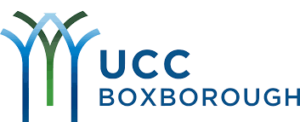 .
. 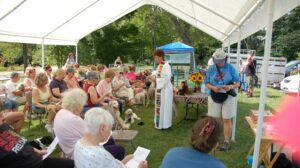
UCC Boxborough has long been aware of the tendency of individuals to connect primarily with people that mirror their own culture, economic status, age group, and beliefs. Over the past couple of years, the town has had multiple incidents of overt racism that have made conversations about race more urgent, and COVID has revealed a lot of loneliness and economic need in the area. The Faith in Action team, pastor, and the wider church were active in responding to community needs during COVID, and a new “Nurturing Racial Justice” team fostered conversations about race and bias within the church. All this led the congregational team to ask: “What if we created a community space that naturally brought different town groups (diverse in culture, economic status, age, and beliefs) together for conversation, play and food? How might that address the underlying loneliness and foster conversations that could address local issues?” To do this, UCC Boxborough built on an existing “free market” where gleaned food is offered without any pre-qualifications. While the market’s reach and offerings were growing organically, the grant provided funds for “the missing link” – enough fun activities, such as a creative play area, enticing people to stay longer. By adding tables, chairs, lemonade, and conversation partners of various ages, time and space were created to listen to people’s interests, and to discover gifts, talents and needs of neighbors. In short, space was created to dream, collectively, of a better world.
Newman Congregational Church, Rumford, Rhode Island
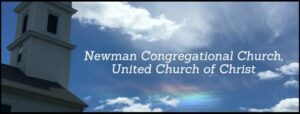
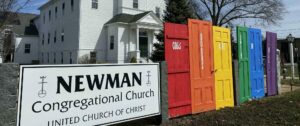
Through all its programs, Newman Congregational Church strives to be a more inclusive and welcoming community that expresses an extravagant welcome both physically in person or online. For this project, the congregational team wrote, “We hope to step more deeply into the phrase, ‘No matter who you are or where you are from, you are welcome here,’” by asking the “what if” question: “What if we used creativity to explore how to become a community of equity and inclusivity?” Newman Congregational proposed undertaking a series of four creative arts workshops to address the topics of white supremacy, stereotype threat, intersectionality, allyship, and inclusivity. Using literature, art, stories, music, and a collective project utilizing the arts, these workshops were designed to lay the foundation for a future “Racial Equity Summit.”
Trinity Episcopal Church, Lewiston, Maine
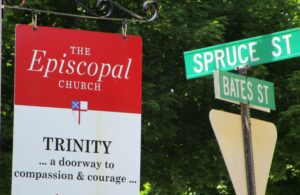 .
. 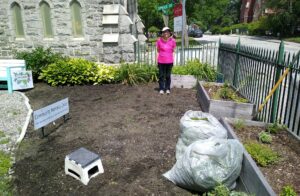
Trinity is a small urban congregation in a racially, ethnically, religiously diverse area with a poverty rate of over 40%. Their mission statement is “A doorway to compassion and courage: empowering members, serving neighbors.” The church has been asking a big “what if” question for the last year: “What if Trinity were to partner with others to transform our worship space so that in addition to worship, it could become a universally welcoming, accessible, well ventilated, up-to-code space for use in and by the neighborhood?” The grant team wondered about choosing one simple project they could do right now – within that larger vision – that would lead forward as an outward and visible sign of re-birth and help to engage with neighbors right now. A number of years ago, a memorial garden was created in the tiny, neglected church yard. After a murder in the park next door, a peace pole was added to the space with the word “peace” in a dozen languages spoken in the neighborhood. It is an inviting, restful pocket park alongside a busy city street. Working with Maine Audubon, the church created a plan to remove invasive plants and to re-landscape the area with native plants that are bird and pollinator friendly. The grant helped to fund work on the transformation of the garden, “an outward and visible sign of our inward and spiritual strength!” and laid the groundwork for the larger project of transforming the church.


